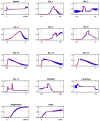Assessment of habitat suitability of the snow leopard (Panthera uncia) in Qomolangma National Nature Reserve based on MaxEnt modeling
- PMID: 29872029
- PMCID: PMC6085764
- DOI: 10.24272/j.issn.2095-8137.2018.057
Assessment of habitat suitability of the snow leopard (Panthera uncia) in Qomolangma National Nature Reserve based on MaxEnt modeling
Abstract
Habitat evaluation constitutes an important and fundamental step in the management of wildlife populations and conservation policy planning. Geographic information system (GIS) and species presence data provide the means by which such evaluation can be done. Maximum Entropy (MaxEnt) is widely used in habitat suitability modeling due to its power of accuracy and additional descriptive properties. To survey snow leopard populations in Qomolangma (Mt. Everest, QNNR) National Nature Reserve, Tibet, China, we pooled 127 pugmarks, 415 scrape marks, and 127 non-invasive identifications of the animal along line transects and recorded 87 occurrences through camera traps from 2014-2017. We adopted the MaxEnt model to generate a map highlighting the extent of suitable snow leopard habitat in QNNR. Results showed that the accuracy of the MaxEnt model was excellent (mean AUC=0.921). Precipitation in the driest quarter, ruggedness, elevation, maximum temperature of the warmest month, and annual mean temperature were the main environmental factors influencing habitat suitability for snow leopards, with contribution rates of 20.0%, 14.4%, 13.3%, 8.7%, and 8.2% respectively. The suitable habitat area extended for 7001.93 km2, representing 22.72% of the whole reserve. The regions bordering Nepal were the main suitable snow leopard habitats and consisted of three separate habitat patches. Our findings revealed that precipitation, temperature conditions, ruggedness, and elevations of around 4000 m influenced snow leopard preferences at the landscape level in QNNR. We advocate further research and cooperation with Nepal to evaluate habitat connectivity and to explore possible proxies of population isolation among these patches. Furthermore, evaluation of subdivisions within the protection zones of QNNR is necessary to improve conservation strategies and enhance protection.
Keywords: Habitat suitability assessment; MaxEnt; Qomolangma National Nature Reserve; Snow leopard; Tibet.
Conflict of interest statement
The authors declare that they have no competing interests.
Figures







Similar articles
-
Modelling potential habitat for snow leopards (Panthera uncia) in Ladakh, India.PLoS One. 2019 Jan 29;14(1):e0211509. doi: 10.1371/journal.pone.0211509. eCollection 2019. PLoS One. 2019. PMID: 30695083 Free PMC article.
-
Role of Tibetan Buddhist monasteries in snow leopard conservation.Conserv Biol. 2014 Feb;28(1):87-94. doi: 10.1111/cobi.12135. Epub 2013 Aug 30. Conserv Biol. 2014. PMID: 23992599
-
Modeling Habitat Suitability of Snow Leopards in Yanchiwan National Reserve, China.Animals (Basel). 2024 Jun 30;14(13):1938. doi: 10.3390/ani14131938. Animals (Basel). 2024. PMID: 38998049 Free PMC article.
-
A spotlight on snow leopard conservation in China.Integr Zool. 2016 Jul;11(4):308-21. doi: 10.1111/1749-4877.12204. Integr Zool. 2016. PMID: 27135283 Review.
-
Prey preferences of the snow leopard (Panthera uncia): regional diet specificity holds global significance for conservation.PLoS One. 2014 Feb 12;9(2):e88349. doi: 10.1371/journal.pone.0088349. eCollection 2014. PLoS One. 2014. PMID: 24533080 Free PMC article. Review.
Cited by
-
Xanthium strumarium L., an invasive species in the subtropics: prediction of potential distribution areas and climate adaptability in Pakistan.BMC Ecol Evol. 2024 Oct 10;24(1):124. doi: 10.1186/s12862-024-02310-6. BMC Ecol Evol. 2024. PMID: 39390368 Free PMC article.
-
Projected impacts of climate change on snow leopard habitat in Qinghai Province, China.Ecol Evol. 2021 Nov 18;11(23):17202-17218. doi: 10.1002/ece3.8358. eCollection 2021 Dec. Ecol Evol. 2021. PMID: 34938503 Free PMC article.
-
Modelling potential habitat for snow leopards (Panthera uncia) in Ladakh, India.PLoS One. 2019 Jan 29;14(1):e0211509. doi: 10.1371/journal.pone.0211509. eCollection 2019. PLoS One. 2019. PMID: 30695083 Free PMC article.
-
From Ecological Niche to Conservation Planning; Climate-Driven Range Dynamics of Ephedra intermedia in Central Asia.Ecol Evol. 2025 Mar 16;15(3):e71127. doi: 10.1002/ece3.71127. eCollection 2025 Mar. Ecol Evol. 2025. PMID: 40092909 Free PMC article.
-
Identifying priority landscapes for conservation of snow leopards in Pakistan.PLoS One. 2020 Nov 5;15(11):e0228832. doi: 10.1371/journal.pone.0228832. eCollection 2020. PLoS One. 2020. PMID: 33151925 Free PMC article.
References
-
- Alexander J.S., Shi K., Tallents L.A., Riordan P. On the high trail: examining determinants of site use by the endangered snow leopard Panthera uncia in Qilianshan, China. Oryx. 2016a;50(2):231–238. doi: 10.1017/S0030605315001027. - DOI
-
- Aryal A., Brunton D., Raubenheimer D. Habitat assessment for the translocation of blue sheep to maintain a viable snow leopard population in the Mt Everest Region, Nepal. Zoology and Ecology. 2013;23(1):66–82. doi: 10.1080/21658005.2013.765634. - DOI
MeSH terms
LinkOut - more resources
Full Text Sources
Other Literature Sources
